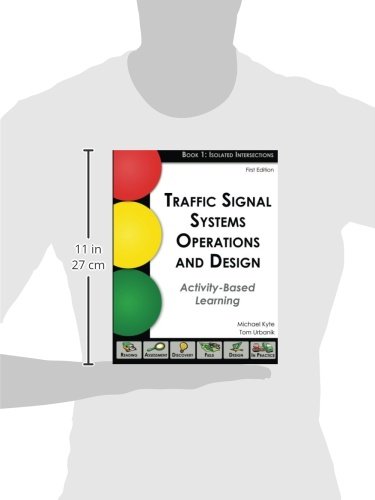
|
|
Product Description
We learn the lessons of traffic control early in life, and with good reason. There are nearly 300,000 traffic signals today in the United States. Each traffic signal performs the task of regulating whose turn it is to go and who must wait. A traffic signal system at its core has two major tasks: move as many users through the intersection as possible and do it with as little conflict between these users as possible. The first task relates to efficiency and capacity while the second relates to safety. Both tasks are performed by first clearly defining which group of users has the right of way at a given time and second by determining how long the group has the right of way.The content in this book is targeted at a senior or graduate level university course in transportation engineering and focuses on the design and operation of one important part of the traffic signal control system: the isolated intersection. Some of the material in this book may also be appropriate for portions of advanced classes in transportation engineering.
Educational research points to a hands-on active learning environment as the best approach to improving student understanding of important concepts. Unlike many courses that emphasize an instructor focus (with lectures presented to students), this book emphasizes a student focus in which you will learn by doing an experiment, analyzing data that you collect, and drawing conclusions about what makes good signal timing practice. This approach requires a more active preparation for each class on your part and a readiness to actively participate in the work of each class. This focus on you means more work but it rewards you with the potential for deeper learning and understanding of this material.
This book is divided into 10 chapters and includes 63 activities. The first four chapters of the book provide a base level of knowledge. Chapters 5 through 9 address specific system components, providing first an understanding of how these components function and secondhow to design them. Finally, Chapter 10 integrates the components together into a final design in which you prepare a report and make a presentation covering your work.
Most chapters have a similar structure. Each chapter begins with a Reading that provides important information on the topics covered in the chapter. A series of activities follow, each providing hands-on experiences with the chapter topic.
- Assessment activities give you the chance to test and apply what you learned in the reading
- Discovery activities provide you with the opportunity to discover new factors or perspectives about the chapter topic by observing animations, collecting or analyzing data, or making calculations
- Field activities allow you to explore traffic flow and control conditions directly in the field and connect your field observations with the theory that you learned in other activities
- Design activities allow you to determine one component of your design and evaluate its performance
- In Practice activities give you the opportunity to compare your understanding or design component with recommended practice from the Traffic Signal Timing Manual
Customers Who Bought This Item Also Bought
- Operation, Analysis, and Design of Signalized Intersections: A Module for the Introductory Course in Transportation Engineering
- Fundamentals of Hydraulic Engineering Systems (5th Edition)
- Hydrology for Engineers, Geologists, and Environmental Professionals, Second Edition: An Integrated Treatment of Surface, Subsurface, and Contaminant Hydrology
- Principles of Foundation Engineering
- Elementary Surveying: An Introduction to Geomatics (15th Edition)
- Structural Analysis (10th Edition)
- Fundamentals of Engineering Thermodynamics
- Engineering Mechanics: Dynamics (14th Edition)
- Principles of Geotechnical Engineering
- Geotechnical Engineering Principles and Practices
*If this is not the "Traffic Signal Systems Operations and Design: An Activity-Based Learning Approach (Book 1: Isolated " product you were looking for, you can check the other results by clicking this link







